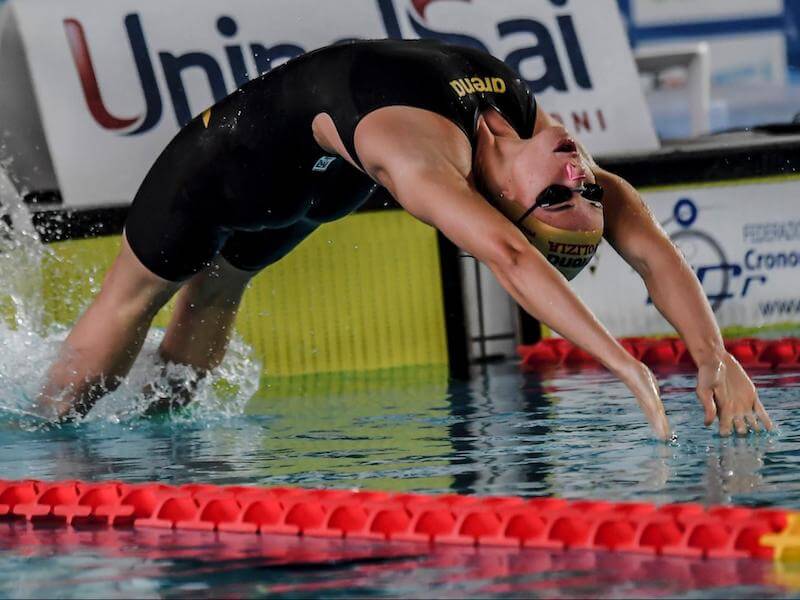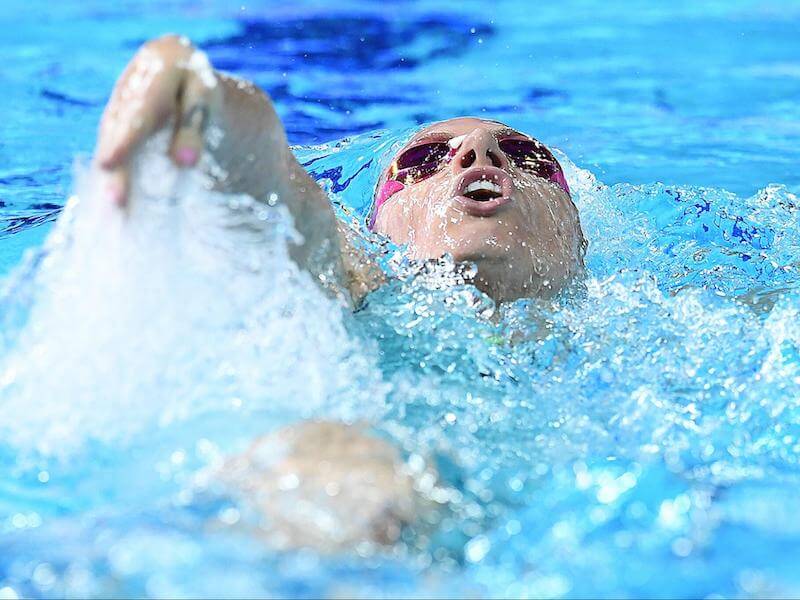How to Improve Your Backstroke: Tips and Drills
The backstroke is an exciting and unique event. All the elements of this swimming stroke are very different from other styles of swim. The start, underwater phase, turns, and the swimming form itself all need to be practiced meticulously so you can learn how to swim backstroke with perfect technique.
After reading this article, you will understand the appropriate form for all the components that make up the backstroke event. Plus, we will give some technique tips for you to think about during your next training. We will begin by looking at the backstroke start. Then, we will go over the turn and the underwater phase. After that, we will look into the technique you should focus on while swimming backstroke.
Once you put all these elements together, you will have everything you need to understand how to improve your backstroke technique.
How to Perform Better Backstroke Starts

The start is crucial in all swimming events. In breaststroke, butterfly, and freestyle swimming, you start from the top of the swimming block and execute a forward dive into the pool. The backstroke, however, is the only event where you do not start from the top of the block.
For a backstroke start, you will begin in the water facing the wall. On the bottom of the swimming block, there are handles to hold. With your hands on the handles, place your feet against the wall and pull yourself up into the starting position. From the start position, you will push off the wall and execute your dive.
Here are some things to focus on for your start position:
- Make sure you have a secure grip on the handles.
- Plant your toes and the balls of your feet on the backstroke starting wedge, or if you are starting without a wedge, place them firmly against the wall at or near the surface of the water. If you are starting from a short course pool that has gutters, put the balls of your feet just below the edge of the gutter so your toes can rest on the top of that edge and be slightly out of the water.
- Apply firm pressure through your feet to avoid slipping when you push off the wall.
- Raise your body out of the water by pulling through your arms. You will want to move your head toward the block and raise your glutes to a point near or above the surface of the water. The right position is when your knees create a 90-degree angle.
- Your head position should be neutral, and your back should be straight.
Now that you know the basics for a good starting position, let’s look into what is needed for the dive:
- Your first move should be to push through your arms to begin your body moving backward. (Do this before pushing with your legs so your feet can drive off the wall instead of slipping down the wall).
- Next, simultaneously extend your neck backward and begin pushing through the legs. Focus on exerting as much energy off the wall as you can. Make sure your timing is right and that you are propelling yourself up and back at the same time.
- Arch your back and focus on how you enter the water. Your hands and arms should enter the water first, then your head and shoulders, followed by the rest of your body.
Perfect the Backstroke Streamline
Next, you’ll want to have a good backstroke streamline. The underwater part of the swim is what comes after the start and after each time you push off the wall. You are allowed to swim the first 15 meters underwater, during which you should perform the dolphin kick.
The streamline position for the backstroke is the same as the technique used for the front crawl or butterfly, except you are facing the surface of the water instead of the bottom of the pool.
When in the proper streamline position, you should keep your arms pressed against your ears, and they should be extended in front of you with your hands one on top of the other. Your body should be in a straight line so you can efficiently move through the water.
The propulsive force during your streamline comes from the underwater dolphin kick. If you are just starting out, you have the option of using a regular flutter kick during the underwater phase, but this will be much slower than using a dolphin kick. It is recommended that you learn the dolphin kick to improve your time.
To dolphin kick, put both legs together, and start your motion by bending at your hips then driving your legs upward and downward to propel yourself through the water.
Execute Good Backstroke Flip Turns
The backstroke turn is similar to the freestyle and butterfly turn but with a few key differences.
When you are swimming backstroke, you cannot see the swimming line on the bottom of the pool or the wall. The only way backstrokers know where they are in the pool is by paying attention to the 5-meter flags above them. When you reach these flags, you know you are getting close to the wall.
To develop a good backstroke turn, practice the following:
- First, get used to spotting the flags.
- Once you’ve spotted the flags, figure out how many strokes you take before you need to roll over to start your flip turn. The typical count will be between three and five, but this can vary depending on your stroke rate.
- After you have figured out your stroke count, you will want to roll over after taking your last stroke and keep one arm out, sculling as you glide toward the wall and prepare to flip turn.
- Execute your flip turn and plant your feet on the wall.
- Push off the wall and remain facing the surface of the water. Dolphin kick and streamline into your next lap.
How to Improve Your Backstroke Technique

Now that you have learned how to perform a proper start, streamline, and turn, let’s learn how to improve your backstroke swimming technique. First, we will go over the two common mistakes in body position and then how to fix them. After that, we will take a look at arm motion and kicking technique.
Watch Your Body Position
There are two basic mistakes that are made when swimming backstroke. Both mistakes come from improper body position while moving through the water. The first is having your legs too high in the water, and the second is dropping your hips too low.
If you keep your body in a perfectly horizontal position, your legs will be too close to the surface of the water to serve their purpose. A lot of drive comes from the legs in the backstroke event, so it is important to have your legs low enough in the water so that they can displace enough water to propel you as you kick.
Correcting this mistake sometimes leads to a second imprecision: allowing your hips to sink lower than your feet so that you are in the so-called sitting position. If you find yourself in this position, you will be experiencing large amounts of drag, which will significantly slow you down.
How to Correct Your Body Position
Of the two errors, the second certainly slows you down more, but it is also easier to fix: You simply need to increase the speed of your leg kick and move your chin backward a few centimeters, and the problem is solved!
On the other hand, making sure your body isn’t as high on the water surface requires greater effort. Here are some tips for you to follow:
- Move your chin a few centimeters closer to your chest.
- Try not to push downward with your hand during the pull phase. A pull that has too much downward motion will raise your legs too high.
- Instead, leading with your pinky, let your hand cut through the water to a depth where you can begin to pull along the side of your body.
- Maintain a fluid arm stroke, attempting to rotate-push with your arm as smoothly as possible.
When you train, focus on your body position so you can find the balancing point between your legs being too high and your hips being too low. If you have the chance, try having someone film you while you swim so you can see how you are moving through the water.
Focus On Proper Arm Motion

Like any other stroke, the way you use your arms is vital to your swimming technique. Here are some swimming tips for you to focus on for your backstroke:
- Your hand should exit the water near your thigh. Your thumb should exit the water first with your pinky toward the bottom of the pool. This will help your hand cut through the water as it exits.
- As you take your stroke, your hand should rotate to face away from your body. When your arm enters the water, your pinky should be the first part of your hand to break the surface.
- According to Swimming Science Bulletin, you should not reach directly behind your head because this will cause your hips to sway laterally and create unnecessary drag. Instead, focus on your hand entering the water in between the line of your shoulder and the top of your head.
- Once your hand is in the water, rotate it so you can pull back to your thigh, where you will start the process again.
- Make sure your shoulders are rotating. Backstroke rotation is just as important as it is in the front crawl.
Make Sure You Have a Strong Kick
Improving your backstroke kick goes a long way to improve your swim times. You’ll want to focus on these two things to improve your kick:
- Develop a consistent kicking rate.
- Train your legs in the pool and during dryland training. Strong legs will help your kicking rate and the amount of force you exert with each kick.
Try out the following leg exercises using a kickboard during your next training:
- 25 meters (m) on your back
- 25 m on your right-hand side
- 25 m on your stomach
- 25 m on your left-hand side
In addition to the training mentioned above, be sure to try implementing swim fins and other training tools into your practice sessions for increased leg strength.
Bring Your New Knowledge to the Pool
If you are new to backstroke, remember to take your time and focus on each element. Pay attention to your body position during the start and how you move through the air during your dive. Practice your turns and streamline form so you can take advantage of the underwater phase of your swim. Don’t forget to keep your hips up and your legs low enough in the water so you can swim your fastest.
Remember to go to each training session prepared. Visit Arena Sport so you can get the best gear to start working toward improving your backstroke.
Written by:
arena coaches
Swim coaches, trainers and experts will give you all kinds of tips for performing at your best in both training and races.







